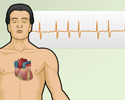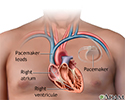Sick sinus syndrome
Bradycardia-tachycardia syndrome; Sinus node dysfunction; Slow heart rate - sick sinus; Tachy-brady syndrome; Sinus pause - sick sinus; Sinus arrest - sick sinus
Normally, the heartbeat starts in an area in the top chambers of the heart (atria). This area is the heart's pacemaker. It may be called the sinoatrial node, sinus node or SA node. This keeps the heart beat steady and regular.
Sick sinus syndrome is a group of heart rhythm problems due to problems with the sinus node, such as:
- The heartbeat rate is too slow, called sinus bradycardia
- The heartbeat pauses or stops, called sinus pauses or sinus arrest
-
Episodes of a fast
heart rate
Heart rate
Paroxysmal supraventricular tachycardia (PSVT) is episodes of rapid heart rate that start in a part of the heart above the ventricles. "Paroxysmal" ...
 ImageRead Article Now Book Mark Article
ImageRead Article Now Book Mark Article - Slow heart rhythms that alternate with fast heart rhythms, called bradycardia-tachycardia or "tachy-brady syndrome"
Causes
Sick sinus syndrome most often occurs in people older than 50. It is often due to scar-like damage to electrical pathways in the heart muscle tissue.
In children, heart surgery on the upper chambers is a common cause of sick sinus syndrome.
Coronary heart disease , high blood pressure, and aortic and mitral valve diseases may occur with sick sinus syndrome. However, these diseases may have nothing to do with the syndrome.
Coronary heart disease
Coronary heart disease is a narrowing of the small blood vessels that supply blood and oxygen to the heart. Coronary heart disease (CHD) is also cal...

Sick sinus syndrome is uncommon. Sinus bradycardia occurs more often than the other types of the condition.
Tachycardias (rapid heart rhythms) that start in the upper chambers of the heart may be part of the syndrome. These include atrial fibrillation, atrial flutter, atrial tachycardia. A period of fast heart rates is often followed by very slow heart rates.
Some medicines can make abnormal heart rhythms worse. These include digitalis, calcium channel blockers, beta-blockers, and antiarrhythmics.
Symptoms
Most of the time, there are no symptoms.
Symptoms that do occur may mimic those of other disorders.
Symptoms may include:
-
Chest pain
or
angina
Chest pain
Chest pain is discomfort or pain that you feel anywhere along the front of your body between your neck and upper abdomen.
 ImageRead Article Now Book Mark Article
ImageRead Article Now Book Mark ArticleAngina
Angina is a type of chest discomfort or pain due to poor blood flow through the blood vessels (coronary vessels) of the heart muscle (myocardium). Th...
Read Article Now Book Mark Article -
Confusion
or other changes in mental status
Confusion
Confusion is the inability to think as clearly or quickly as you normally do. You may feel disoriented and have difficulty paying attention, remembe...
 ImageRead Article Now Book Mark Article
ImageRead Article Now Book Mark Article -
Fainting
or near-fainting
Fainting
Fainting is a brief loss of consciousness due to a drop in blood flow to the brain. The episode most often lasts less than a couple of minutes and y...
Read Article Now Book Mark Article -
Fatigue
Fatigue
Fatigue is a feeling of weariness, tiredness, or lack of energy.
Read Article Now Book Mark Article -
Dizziness
or lightheadedness
Dizziness
Dizziness is a term that is often used to describe 2 different symptoms: lightheadedness and vertigo. Lightheadedness is a feeling that you might fai...
 ImageRead Article Now Book Mark Article
ImageRead Article Now Book Mark Article -
Sensation of feeling the heart beat (
palpitations
)
Palpitations
Palpitations are feelings or sensations that your heart is pounding or racing. They can be felt in your chest, throat, or neck. You may:Have an unpl...
 ImageRead Article Now Book Mark Article
ImageRead Article Now Book Mark Article -
Shortness of breath
, possibly only with physical activity like walking
Shortness of breath
Breathing difficulty may involve:Difficult breathingUncomfortable breathingFeeling like you are not getting enough air
 ImageRead Article Now Book Mark Article
ImageRead Article Now Book Mark Article
Exams and Tests
The heart rate may be very slow at any time. Blood pressure may be normal or low.
Heart rate
The pulse is the number of heartbeats per minute.

Sick sinus syndrome may cause symptoms of heart failure to start or get worse. Sick sinus syndrome is diagnosed when the symptoms occur only during episodes of arrhythmia. However, this is often hard to prove.
Heart failure
Heart failure is a condition in which the heart is no longer able to pump oxygen-rich blood to the rest of the body efficiently. This causes symptom...

An ECG may show abnormal heart rhythms related to this syndrome.
ECG
An electrocardiogram (ECG) is a test that records the electrical activity of the heart.

Holter monitoring is an effective tool for diagnosing sick sinus syndrome. It may pick up very slow heart rates and long pauses, along with episodes of atrial tachycardias. Other forms of long-term electrical monitoring may also be useful.
Holter monitoring
A Holter monitor is a machine that continuously records the heart's rhythms. The monitor is worn for 24 to 48 hours during normal activity.

An intracardiac electrophysiology study (EPS) is a very specific test for this disorder. However, it is not often needed and may not confirm the diagnosis.
Intracardiac electrophysiology study (E...
Intracardiac electrophysiology study (EPS) is a test to look at how well the heart's electrical signals are working. It is used to check for abnorma...

In some cases, a person's heart rate is observed when walking or exercising to see if it increases enough.
Treatment
You may not need treatment if you do not have any symptoms. Your health care provider will review the medicines you take to make sure they are not making your condition worse. Do not stop taking any of your medicines unless your provider tells you to do so.
You may need a permanent implanted pacemaker if your symptoms are related to bradycardia (slow heart rate).
A fast heart rate (tachycardia) may be treated with medicine. Sometimes, a procedure called radiofrequency ablation is used to cure tachycardia.
In some cases, medicines used to control periods of fast heart rate are combined with use of a pacemaker, which guards against periods of slow heart rate.
Outlook (Prognosis)
The syndrome is most often progressive. This means it gets worse over time in most cases.
The long-term outlook is excellent for people who have a permanent pacemaker implanted.
Possible Complications
Complications may include:
- Angina
- Decreased exercise capacity
- Fainting (syncope)
- Falls or injury caused by fainting
- Heart failure
- Poor heart pumping
When to Contact a Medical Professional
Call your provider if you have:
- Lightheadedness
- Fainting
- Palpitations
- Other symptoms of the condition
Prevention
Keeping your heart healthy by eating a well-balanced diet and exercising can prevent many types of heart disease.
You may need to avoid some types of medicines. Many times, the condition is not preventable.
References
Olgin JE, Zipes DP. Specific arrhythmias: diagnosis and treatment. In: Mann DL, Zipes DP, Libby P, Bonow RO, Braunwald E, eds. Braunwald's Heart Disease: A Textbook of Cardiovascular Medicine . 10th ed. Philadelphia, PA: Elsevier Saunders; 2015:chap 37.
Zimetbaum P. Cardiac arrhythmias with supraventricular origin. In: Goldman L, Schafer AI, eds. Goldman's Cecil Medicine . 25th ed. Philadelphia, PA: Elsevier Saunders; 2016:chap 64.
-
Cardiac arrhythmia symptoms
Animation
-
Pacemaker - illustration
A pacemaker is a small, battery-operated electronic device which is inserted under the skin to help the heart beat regularly and at an appropriate rate. The pacemaker has leads that travel through a large vein to the heart, where the wires are anchored. The leads send the electrical impulses to the heart to tell it to beat.
Pacemaker
illustration
-
Pacemaker - illustration
A pacemaker is a small, battery-operated electronic device which is inserted under the skin to help the heart beat regularly and at an appropriate rate. The pacemaker has leads that travel through a large vein to the heart, where the wires are anchored. The leads send the electrical impulses to the heart to tell it to beat.
Pacemaker
illustration
Review Date: 2/24/2016
Reviewed By: Michael A. Chen, MD, PhD, Associate Professor of Medicine, Division of Cardiology, Harborview Medical Center, University of Washington Medical School, Seattle, WA. Also reviewed by David Zieve, MD, MHA, Isla Ogilvie, PhD, and the A.D.A.M. Editorial team.



